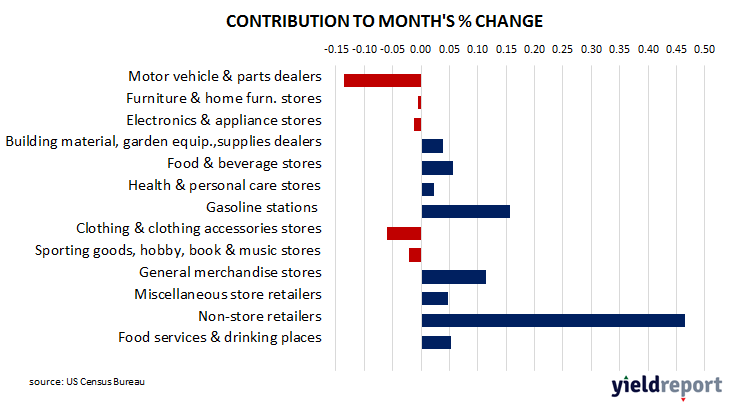Summary: US retail sales up 0.7% in March, greater than expected; annual growth rate accelerates to 4.0%; ANZ: data confirms healthy consumption, solid economic growth; US Treasury yields rise; 2024 rate-cut expectations soften; higher sales in eight of thirteen categories; “non-store retailers” largest single influence on month’s result.
US retail sales had been trending up since late 2015 but, commencing in late 2018, a series of weak or negative monthly results led to a drop-off in the annual growth rate below 2.0%. Growth rates then increased in trend terms through 2019 and into early 2020 until pandemic restrictions sent them into negative territory. A “v-shaped” recovery then took place which was followed by some short-term spikes as federal stimulus payments hit US households in the first and second quarters of 2021.
According to the latest “advance” numbers released by the US Census Bureau, total retail sales increased by 0.7% in March. The result was greater than the 0.4% increase which had been generally expected but less than February’s 0.9% gain after it was revised up from 0.6%. On an annual basis, the growth rate accelerated from February’s revised rate of 2.1% to 4.0%.
“Control group sales, which are used to prepare estimates for GDP, rose 1.1% month-on-month and the February data were revised up 0.3% m/m from 0.0%,” said ANZ economist Madeline Dunk. “The data confirmed healthy consumption and solid economic growth, reflecting the current strength in hiring.”
US Treasury bond yields rose by increasing amounts across the curve on the day. By the close of business, the 2-year Treasury yield had added 3bps to 4.92%, the 10-year yield had gained 9bps to 4.61% while the 30-year yield finished 11bps higher at 4.73%.
In terms of US Fed policy, expectations of a lower federal funds rate in the next 12 months softened, although at least two 25bps cuts are still currently factored in. At the close of business, contracts implied the effective federal funds rate would average 5.32% in May, 1bp less than the current spot rate, 5.29% in June and 5.27% in July. However, April 2025 contracts implied 4.71%, 62bps less than the current rate.
“The three-month average of control group sales is running at 0.4% month-on-month, which crudely equates to real personal consumption growth in the region of 2.0%–2.5% in Q1,” Dunk added.
Eight of the thirteen categories recorded higher sales over the month. The “Non-store retailers” segment provided the largest single influence on the overall result, rising by 2.7% over the month and contributing 0.46 percentage points to the total.
The non-store segment includes vending machine sales, door-to-door sales and mail-order sales but nowadays this segment has become dominated by online sales. It accounts for over 17% of all US retail sales and it is the second-largest segment after vehicles and parts.



